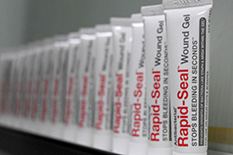Scrape? Cut? Seal It with Game-Changing Product Created at UMD
Rapid-Seal®, a new gel that can stop bleeding in seconds, has hit both virtual and brick-and-mortar shelves as the first consumer product released by Medcura Inc., a company launched at the University of Maryland. The new gel is available through Amazon and at a leading chain of pharmacies. Rapid-Seal uses a proprietary modification of chitosan, a nontoxic, biodegradable biopolymer found in the shells of crustaceans and certain plants, to seal minor cuts and scrapes while preventing harmful bacteria from growing. “Our platform has great inherent flexibility, allowing us to precisely engineer materials for a given injury,” said Matthew Dowling, Chief Scientific Officer and Director of Medcura. “Rapid-Seal® is the first of many high-performance, easy-to-use tools we are developing to address almost any injury that requires bleeding management—whether planned, as in surgery, or unplanned, as in accidents or combat.” Development of the Rapid Seal technology began in UMD’s A. James Clark School of Engineering in a lab led by Department of Chemical and Biomolecular Engineering Professor Srinivasa Raghavan. “It was scientific curiosity,” said Raghavan. “We had modified the polymer chitosan, and we wanted to test what would happen if we added it to blood. When Matt joined the lab, he quickly made a remarkable discovery.” Dowling joined the lab as a bioengineering doctoral student (’10) in 2005, funded by the Fischell Fellowship in Biomedical Engineering, which recognizes innovative graduate students interested in applied research and product design. He and Raghavan discovered that their polymer instantly converted liquid blood into a gel. “When our body clots blood at the site of an injury, it again involves the conversion of blood to a gel,” Raghavan explained. “So, it occurred to us that our blood-gelling polymer could potentially stop bleeding from wounds.” Dowling and Raghavan worked with faculty at the University of Maryland School of Medicine to test their discovery. “We found that our polymer was able to stop even the most severe bleeding,” said Raghavan. The pair knew they were onto something. They applied for a patent, together with their medical school collaborators. That patent won a University of Maryland Office of Technology Commercialization (OTC) Invention of the Year Award in 2009 in the Life Sciences Category. To bring their invention to market, Dowling then launched Medcura and licensed the technology from the university. Dowling next procured funding from the Maryland Industrial Partnerships (MIPS) Program. “MIPS was the first R&D grant Medcura obtained, and as such, provided us with tangible results that supported our approach,” said Dowling. “This served as the foundation for further funding of downstream studies.” That funding included grants from the National Science Foundation (NSF) Small Business Innovation Research (SBIR) program, the Air Force Medical Assistance Program and the Maryland Biotechnology Center, part of the state’s Department of Business and Economic Development. Medcura then entered Mtech Ventures, an incubator in the Clark School’s Maryland Technology Enterprise Institute (Mtech) designed to help innovators build successful companies around technology-based innovations created at the University of Maryland. In 2016, the company hired Larry Tiffany, a serial life science entrepreneur and former executive at Gene Logic. The company then raised $3.1 million in an initial round of financing, led by early-stage investment funds and life science investors, including the Dingman Center for Entrepreneurship and UM Ventures. In 2017, Medcura received U.S. Food and Drug Administration (FDA) 510(k) clearance for use of its advanced bandage for prescription and over-the-counter uses, the first-ever designation of its kind for a University of Maryland-originating technology. Larger grants followed for Medcura, $3.4 million of which came from the Department of Defense (DoD). The U.S. Army Medical Research & Medical Command (USAMRMC) provided funding to develop an implantable solution for prolonged field care. That solution, called LifeFoam™, was awarded “breakthrough device” status by the FDA for the treatment of severe, internal, life-threatening hemorrhage on the battlefield. Paving the way for Rapid-Seal®, Medcura acquired additional FDA 510(k) clearances in 2018 for over-the-counter use of its first flowable hemostat, expanding the company’s label to include the use of gels and bandages in the local management of bleeding while providing an antibacterial barrier. In 2020, Medcura moved into the University of Maryland Discovery District, which offers flexible research and development buildings for growing business ventures. “The Discovery District was perfect for us,” Tiffany said. “Working in collaboration with Ken Ulman and his team at Terrapin Development, we were able to quickly scale the manufacturing of our core active ingredient to meet consumer demand.” "Medcura is a shining example of the power of research to drive innovation, as well as of our ecosystem to translate that research into impact,” said UMD Chief Innovation Officer Julie Lenzer. “We look forward to continuing to support them in their success." The company’s future product plans include LifeFoam™, LifeGel™, its lead surgical candidate, and LifeDust™, a powder that can be delivered onto external traumatic injuries as a spray. “We are at the cusp of our corporate arc,” said Tiffany. “By leveraging the foundation created in the UMD Clark School of Engineering, we plan to change the way bleeding is managed—from the backyard to the battlefield.” Medcura has seven U.S. patents and one granted European patent, with multiple patents pending. “The story of Medcura and Rapid-Seal® is a terrific example of a fundamental discovery made in the lab that was translated into a technology that could save lives,” said Raghavan. “It all started with, curiosity-driven scientific research.”
July 15, 2021 Prev Next |


